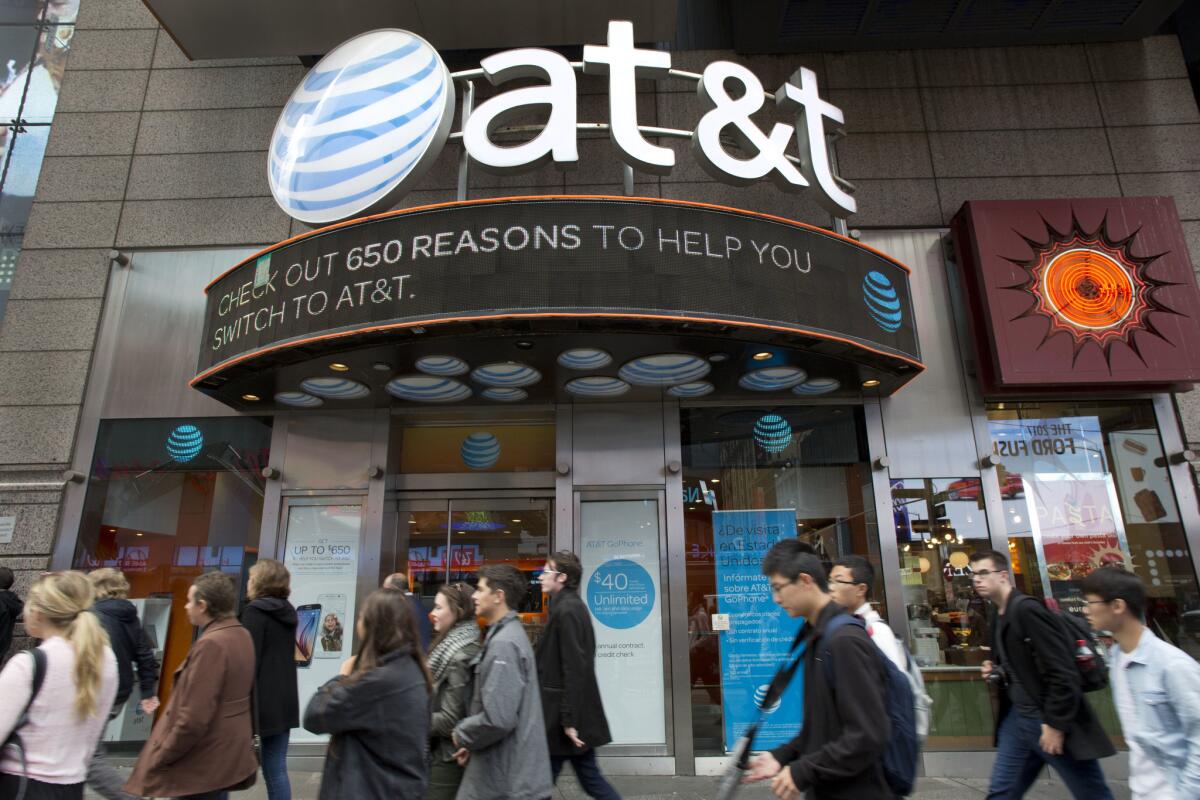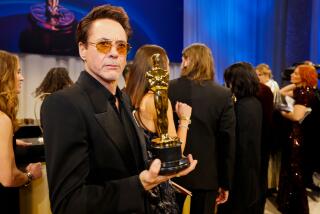AT&T and Time Warner hope to break the cycle of failed mergers

AT&T’s blockbuster bid for Time Warner Inc. might be a boon for investment bankers, lawyers and lobbyists, but it is anyone’s guess whether investors, employees and consumers ultimately would benefit from the combination.
Since the $85.4-billion deal was unveiled last weekend, AT&T Chief Executive Randall Stephenson and Time Warner Inc. Chief Executive Jeffrey Bewkes have extolled the advantages of marrying the nation’s second largest wireless phone provider with a leading entertainment company, which owns such assets as HBO, CNN, TBS, Cartoon Network and the Warner Bros. film and TV studio in Burbank.
AT&T estimated that it could achieve $1 billion in cost savings in three years after buying Time Warner. Stephenson promised the merger would transform media because AT&T would be able to create new subscription and advertising models. Time Warner movies and popular TV shows like “The Big Bang Theory” could be promoted to AT&T cellphone customers.
But some analysts have expressed doubts that such a massive tie-up will pan out the way that Stephenson and Bewkes hope — should the federal regulators allow the two companies to come together. There’s good reason for skepticism: Many mergers fail to live up to the hype.
“Most of them don’t work out,” said Rita Gunther McGrath, a management professor at Columbia Business School. “And the success rates for the big ones are abysmal.”
Problems include challenges integrating disparate business units, conflicts in corporate culture and getting beat by rivals who respond faster to changes in market conditions.
Notable failures include Boston Scientific’s $27-billion purchase in 2006 of Guidant to create a dominant medical device company. It resulted in billions of dollars in write-downs and years of litigation. The 2005 combination of retailers Sears and K-Mart was supposed to strengthen the two chains, but instead they fell further behind and K-Mart has been shuttering stores.
The Quaker Oats Co. bought the hugely popular Snapple tea and fruit drink business for $1.7 billion in 1994. Three years later, following marketing missteps and problems with distributors, Quaker unloaded Snapple to Triarc Cos. for $300 million.
Here’s a look at major mergers in the media space:
AOL-Time Warner for $103.5 billion (2000)
The biggest failure of them all was another deal that involved Time Warner. The deal, announced with great fanfare in January 2000, was billed as the coming of age for the Internet. Although the premise — that the Internet would become a major distribution outlet for entertainment — was correct, AOL turned out to be a weak vehicle. The purchase price, which came at the height of the dot.com boom, was staggering because it was based on AOL’s frothy levels of stock trading.
“The whole thing was built on a house of cards,” McGrath said. “The timing was off, the deal came on the brink of when the stock market bubble was about to burst.”
More than $100 billion in market value evaporated. The result was billions of dollars in write-downs, hundreds of layoffs, an exodus of top executives, destroyed pensions and none of the so-called synergies. Time Warner executives were hostile to their new corporate bosses because they recognized that Time Warner had the stronger businesses, and AOL was weighing down the company. Cultural conflicts were large and small.
AOL management, a couple years into the union, lost credibility amid revelations that AOL had been inflating its advertising revenue, which prompted investigations by the Securities and Exchange Commission and the Department of Justice. AOL lost even more of its luster with the arrival of high-speed Internet access, which was vastly superior to AOL’s dial-up service. Time Warner spun off AOL in late 2009.
Vivendi-Universal for $34 billion (2000)
On the heels of AOL-Time Warner was a merger between a French conglomerate, Vivendi, and Canadian-based Seagram Co., which included Universal’s theme park, movies, television and music businesses.
Vivendi’s French Chief Executive Jean Marie Messier had a vision in which Internet-connected cellphones deliver music and entertainment to the masses. He boasted about generating revenue by selling phone ringtones. But investors had trouble reconciling the diversity of Vivendi’s sprawling assets, which included water and sewer systems and a pay-TV service in France. What’s more, the phone technology didn’t support his grand plan and an acquisition spree of various assets left the company drowning in debt. Shareholders rebelled, and Messier was forced out.
Vivendi in 2004 sold the majority stake of its Universal assets (except for Universal Music Group) to NBC’s owner, General Electric, for $14 billion, which allowed GE to diversify its holdings and create a new conglomerate, NBCUniversal.
Viacom-CBS for $34.8 billion (2000)
Media mogul Sumner Redstone added CBS to his media company Viacom in 2000 amid the last wave of media consolidation, combining such strong cable channels as MTV, Nickelodeon, Comedy Central and VH1 with the CBS television network and Infinity radio stations.
Six years later, Redstone divided his empire into two separate publicly traded companies. He wanted to give two trusted managers, Viacom’s Tom Freston and CBS’ Leslie Moonves, their own corporate fiefdoms. He also didn’t want the “old” media company, CBS, to weigh down the growth of Viacom, which was then red-hot on Wall Street.
Today, the circumstances have reversed. CBS is strong, Viacom is struggling and the two companies are mulling a reunion, proposed by Redstone’s influential daughter, Shari Redstone. “What she’s saying is: Let’s put Humpty Dumpty back together and we will get the benefits of consolidation,” said C. Kerry Fields, a finance professor at the USC Marshall School of Business.
News Corp.-MySpace for $580 million (2005)
Rupert Murdoch snatched social networking site MySpace for $580 million in 2005 and the deal was viewed as a master stroke.
MySpace had been the world’s fastest-growing social network, attracting 20 million unique visitors each month in the U.S. But it struggled to adapt to changing consumer preferences and was soon eclipsed by Facebook.
The site lost users and vital advertising revenue and became a black eye for News Corp. Six years after buying it, News Corp. sold MySpace for a measly $35 million.
Comcast-NBCUniversal for $30 billion (2011)
The tie-up between the Philadelphia cable operator and NBCUniversal is one notable success. Comcast bought the company in December 2009 when General Electric was struggling to recover from the recession. Comcast structured favorable terms that allowed it to use NBCUniversal profits to reimburse GE, which had owned NBC since 1986.
After taking control in 2011, Comcast immediately installed a new regime at NBC, and significantly increased investment in programming. Under GE, the company curtailed spending — including at NBC television stations — and the peacock network was in a tailspin.
“When we came, NBC was No. 4 for seven years in a row,” NBCUniversal Chief Executive Steve Burke told analysts Wednesday. “NBC is starting the fourth season in a row as No. 1. We’ve had two record years at Universal Studios. Our theme park business has tripled or quadrupled.”
In addition, Comcast has heavily promoted NBC events and movies to its more than 22 million cable TV subscribers — boosting viewership. For example, ratings for NBC’s Rio de Janeiro Summer Olympics coverage was 20% higher in Comcast homes.
“They had thoughtful managers who really knew what they wanted out of that deal, and that was to create good products,” Fields said. “They haven’t missed a beat and, in this case, that over-used word ‘synergy’ truly works.”
See the most-read stories in Entertainment this hour »
More to Read
From the Oscars to the Emmys.
Get the Envelope newsletter for exclusive awards season coverage, behind-the-scenes stories from the Envelope podcast and columnist Glenn Whipp’s must-read analysis.
You may occasionally receive promotional content from the Los Angeles Times.







